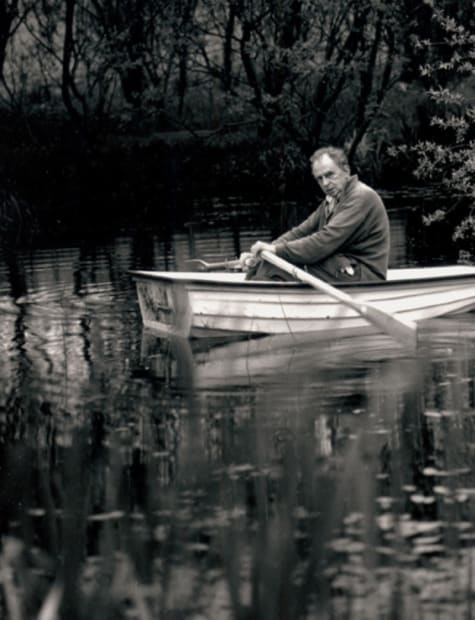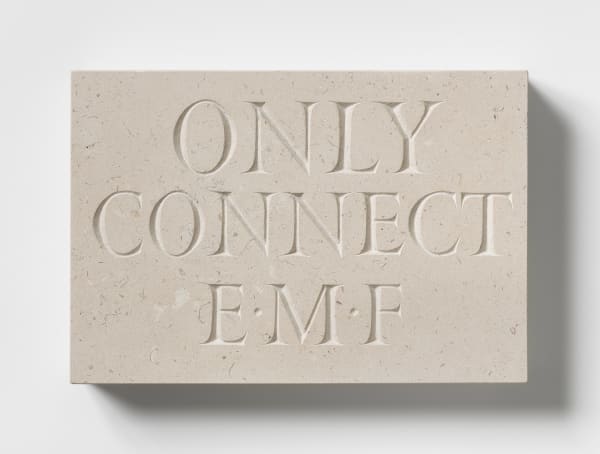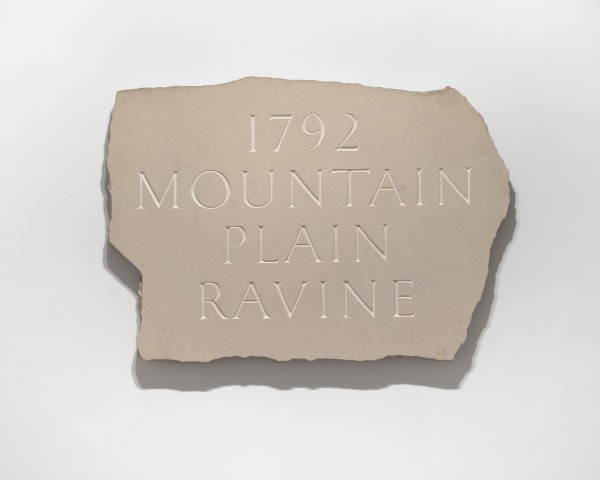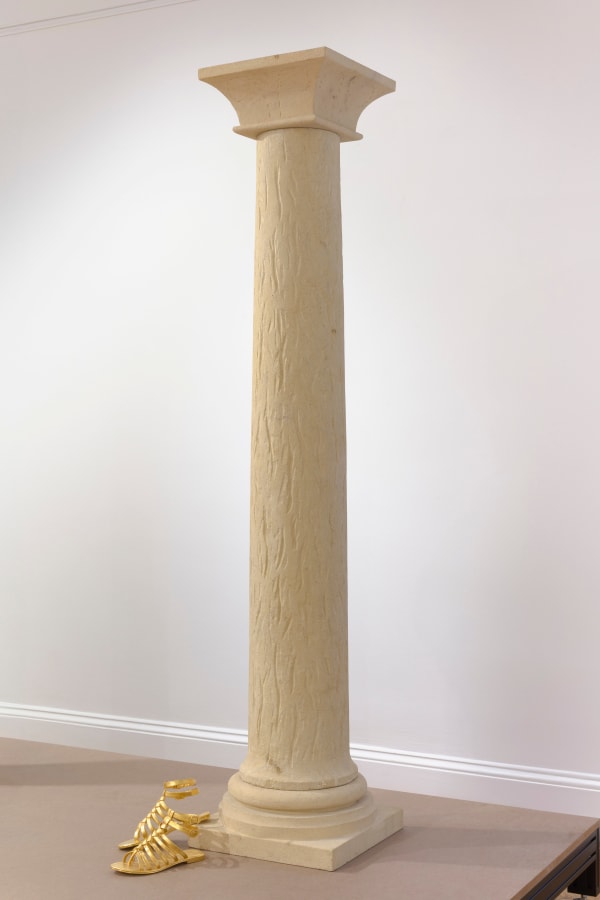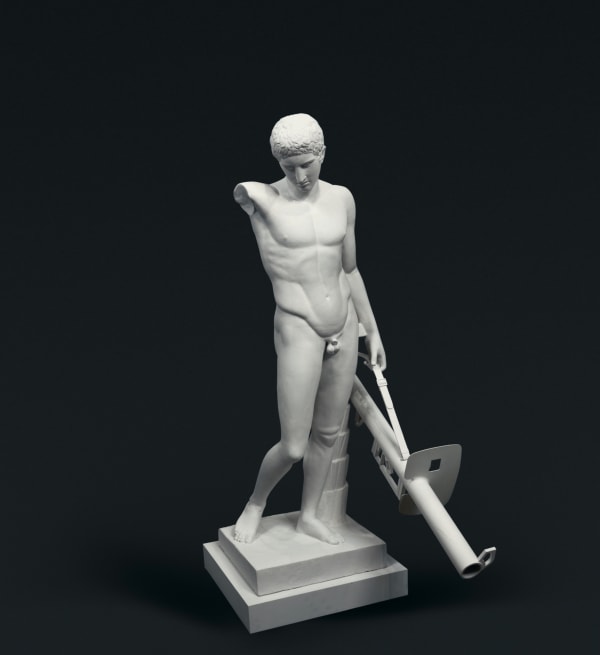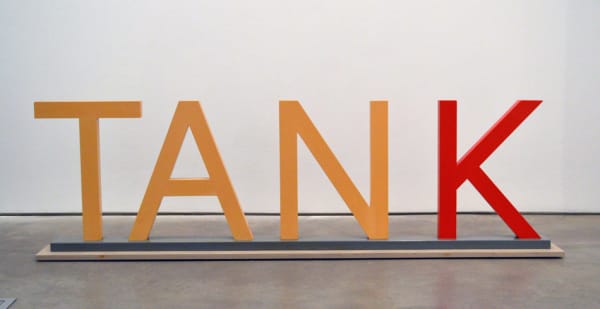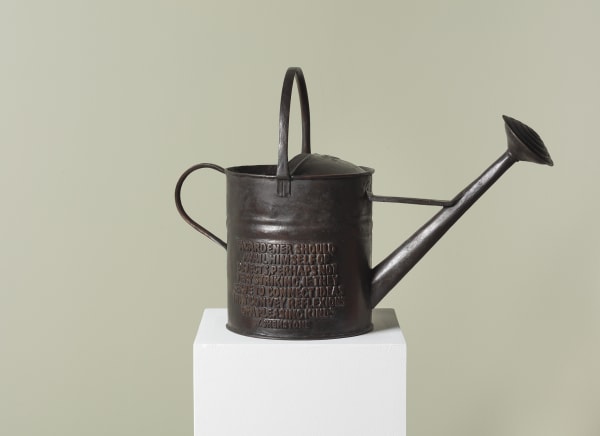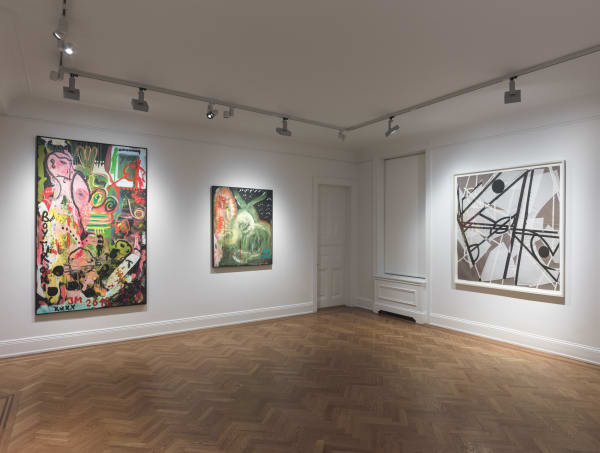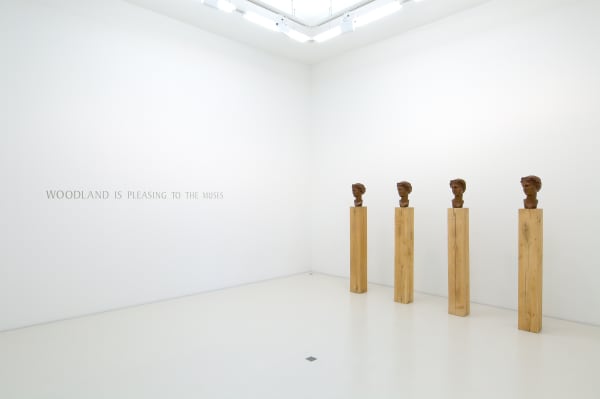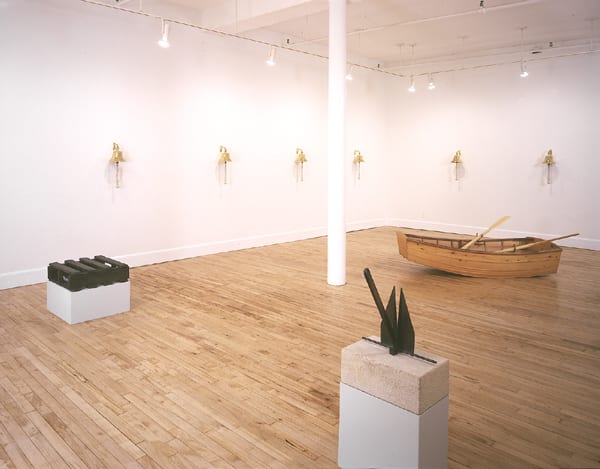-

-
-
 Ian Hamilton FinlayL'Idylle des Cerises, 2005stone, in two parts, with Peter Coatesplaque: 23 5/8 x 47 1/4 x 1 5/8 in (60 x 120 x 4 cm)
Ian Hamilton FinlayL'Idylle des Cerises, 2005stone, in two parts, with Peter Coatesplaque: 23 5/8 x 47 1/4 x 1 5/8 in (60 x 120 x 4 cm)
basket: 17 3/4 x 21 1/4 in (45 x 54 cm)
plinth: 3 x 11 3/4 x 11 3/4 in (7.5 x 30 x 30 cm) -
 Ian Hamilton FinlayOnly Connect, 1998stone, with John Andrew7 7/8 x 11 1/2 x 1 7/8 in (20 x 29.2 x 4.7 cm)
Ian Hamilton FinlayOnly Connect, 1998stone, with John Andrew7 7/8 x 11 1/2 x 1 7/8 in (20 x 29.2 x 4.7 cm) -
 Ian Hamilton FinlayFive Benches for a Lane, 1998five hand-inscribed teak benches, with Bob Lewiseach: 15 x 37 x 10.5 in (38 x 94 x 26.5 cm)
Ian Hamilton FinlayFive Benches for a Lane, 1998five hand-inscribed teak benches, with Bob Lewiseach: 15 x 37 x 10.5 in (38 x 94 x 26.5 cm) -
 Ian Hamilton FinlayPsalm 129 v.3, 1997wood and brass, with John Andrew15 3/4 x 53 1/8 x 2 in (40 x 135 x 5 cm)
Ian Hamilton FinlayPsalm 129 v.3, 1997wood and brass, with John Andrew15 3/4 x 53 1/8 x 2 in (40 x 135 x 5 cm) -
 Ian Hamilton FinlayHomage to Seurat, 1995wall painting, painted wheelbarrow, painted hoe, painted watering can, with Gary Hincks and Candida Ballantynewall painting: dimensions variable
Ian Hamilton FinlayHomage to Seurat, 1995wall painting, painted wheelbarrow, painted hoe, painted watering can, with Gary Hincks and Candida Ballantynewall painting: dimensions variable
wheelbarrow: 18 1/8 x 52 x 22 1/8 in (46 x 132 x 56 cm)
hoe: 61 3/8 x 4 7/8 x 1 5/8 in (156 x 12.5 x 4 cm)
watering can: 15 3/4 x 24 3/8 x 8 7/8 in (40 x 62 x 22.5 cm) -
 Ian Hamilton FinlayAge Quod Agis / Rubbing Post for a Wild Boar, 1997stone, with Peter Coates60 1/4 x 8 1/8 in (153 x 20.6 cm)
Ian Hamilton FinlayAge Quod Agis / Rubbing Post for a Wild Boar, 1997stone, with Peter Coates60 1/4 x 8 1/8 in (153 x 20.6 cm) -
 Ian Hamilton Finlay1789 Ribbons with Everything, 1994Purebeck Portland stone, carved by Annet Stirling31 x 48 1/4 x 2 in (78.7 x 122.6 x 5.1 cm)
Ian Hamilton Finlay1789 Ribbons with Everything, 1994Purebeck Portland stone, carved by Annet Stirling31 x 48 1/4 x 2 in (78.7 x 122.6 x 5.1 cm) -
 Ian Hamilton FinlayRough Oars with the Leaves Still on Them (Virgil, Aeneid Bk. IV), with Peter Coates, 1996stone4 x 18 x 13 in (10 x 46 x 33 cm)
Ian Hamilton FinlayRough Oars with the Leaves Still on Them (Virgil, Aeneid Bk. IV), with Peter Coates, 1996stone4 x 18 x 13 in (10 x 46 x 33 cm) -
 Ian Hamilton Finlay1792 Mountain Plain Ravine, 1994Purbeck Portland stone, with Annet Stirling30 x 43 1/4 x 2 in (76.2 x 109.9 x 5.1 cm)
Ian Hamilton Finlay1792 Mountain Plain Ravine, 1994Purbeck Portland stone, with Annet Stirling30 x 43 1/4 x 2 in (76.2 x 109.9 x 5.1 cm) -
 Ian Hamilton FinlayEvery Goal Negates (L. Feuerbach), with John Andrew, 1987stone16 1/8 x 106 1/4 x 1 1/8 in (41 x 270 x 3 cm)
Ian Hamilton FinlayEvery Goal Negates (L. Feuerbach), with John Andrew, 1987stone16 1/8 x 106 1/4 x 1 1/8 in (41 x 270 x 3 cm) -
 Ian Hamilton FinlayDryad, 1987stone and metal, with John Sellman and Eva Bai74 x 15 1/2 x 15 1/2 in (188 x 39.5 x 39.5 cm)
Ian Hamilton FinlayDryad, 1987stone and metal, with John Sellman and Eva Bai74 x 15 1/2 x 15 1/2 in (188 x 39.5 x 39.5 cm) -
 Ian Hamilton FinlayArbor Felice Arbor Philhellene / The Birch Tree Recalls You O Philhellenes, 1985two ceramic tree plaques, with David Ballantyne36 1/2 x 12 1/2 in (92.7 x 31.7 cm)
Ian Hamilton FinlayArbor Felice Arbor Philhellene / The Birch Tree Recalls You O Philhellenes, 1985two ceramic tree plaques, with David Ballantyne36 1/2 x 12 1/2 in (92.7 x 31.7 cm)
35 x 12 1/2 in (88.8 x 31.8 cm) -
 Ian Hamilton FinlayAphrodite of the Pastoral, 1993plaster and US Army desert sand camouflage jacket60 1/4 x 18 x 21 in (153 x 45.7 x 53.3 cm)
Ian Hamilton FinlayAphrodite of the Pastoral, 1993plaster and US Army desert sand camouflage jacket60 1/4 x 18 x 21 in (153 x 45.7 x 53.3 cm) -
 Ian Hamilton FinlayMan With Panzerschreck, 1993plaster and metal61 x 17 3/8 x 19 1/4 in (155 x 44 x 49 cm)
Ian Hamilton FinlayMan With Panzerschreck, 1993plaster and metal61 x 17 3/8 x 19 1/4 in (155 x 44 x 49 cm) -
 Ian Hamilton FinlayTank, 1991painted wood, with Jim Brennan21.26 x 71.65 x 4.33 in (54 x 182 x 11 cm)
Ian Hamilton FinlayTank, 1991painted wood, with Jim Brennan21.26 x 71.65 x 4.33 in (54 x 182 x 11 cm) -
 Ian Hamilton FinlayRevolution, N., 1991wood, clay flowerpots, lithographsstands:
Ian Hamilton FinlayRevolution, N., 1991wood, clay flowerpots, lithographsstands:
37 1/2 x 7 x 7 in (95 x 18 x 18 cm)
lectern:
47 1/4 x 17 x 17 1/3 in (120 x 43 x 44 cm) -
 Ian Hamilton FinlayWatering Can (Shenstone), 1995bronze, with John Andrew15 3/4 x 23 1/2 x 11 3/4 in (40 x 60 x 30 cm)
Ian Hamilton FinlayWatering Can (Shenstone), 1995bronze, with John Andrew15 3/4 x 23 1/2 x 11 3/4 in (40 x 60 x 30 cm) -
 Ian Hamilton FinlayUrn 1794, 1993stone, with Peter Coates17 3/4 x 10 5/8 x 10 5/8 in (45 x 27 x 27 cm)
Ian Hamilton FinlayUrn 1794, 1993stone, with Peter Coates17 3/4 x 10 5/8 x 10 5/8 in (45 x 27 x 27 cm)
-
-
Press
-
Ian Hamilton Finlay: Fragments
Alfred Mac Adam · Brooklyn Rail May 21, 2025Gardening may be divided into three species: kitchen gardening—parterre-gardening—and landskip, or picturesque-gardening… It consists in pleasing the imagination by scenes of grandeur, beauty, or variety. Convenience merely has no share... -
Ian Hamilton Finlay at 100: A Century of Concrete Poetry and Classical Resistance
Artnet Gallery Network · Artnet May 15, 2025In New York, David Nolan Gallery presents a centennial exhibition on the pioneering artist, poet, and gardener. Artist, poet, philosopher, gardener, the multihyphenate Ian Hamilton Finlay (1925–2006) created a body... -
What's on our Cultural Calendar this May
Ingrid Abramovitch · Elle Decor May 13, 2025Our editors’ picks for the best design, art, and architecture happenings around. IAN HAMILTON FINLAY: FRAGMENTS AT DAVID NOLAN GALLERY New York City Philosopher. Sculptor. Poet. Gardener. The late Scottish... -
The polarising poet, sculptor and ‘avant-gardener’ who maintained a private militia
Digby Warde-Aldam · The Spectator April 26, 2025On the centenary of his birth, we remember visionary artist Ian Hamilton Finlay, whose heavies, the 'Saint-Just Vigilantes’, once vandalised the offices of Apollo magazine Not many artists engage in... -
Written on Tablets of Stonypath
Alec Finlay · The World of Interiors April 23, 2025The poet and artist Ian Hamilton Finlay was a man of fragile disposition and fixed – but not always logical – views. He made model toys that weren’t to be... -
Ian Hamilton Finlay: The groundbreaking artist and poet who created ‘Little Sparta’
Tom Lubbock · The Independent April 21, 2025The revolutionary Scotsman, who created in his Lanarkshire garden 'Little Sparta', would have turned 100 this year Ian Hamilton Finlay, poet and artist: born Nassau, Bahamas 28 October 1925; CBE... -
Dare you journey to Little Sparta — a point of no return?
Natalie Whittle · Financial Times April 18, 2025On the centenary of the birth of Ian Hamilton Finlay — poet, iconoclast, social revolutionary and maritime obsessive — his Scottish garden is being celebrated as his greatest work of... -
Ian Hamilton Finlay review – the visionary Scottish poet-artist’s mind in closeup
Laura Cumming · The Guardian March 23, 2025Words and ideas are as one – and at war – in Finlay’s witty, elegant work, from sculptures to screenprints, which are ideally displayed in this intimate centenary show Star/Steer... -
Who was Ian Hamilton Finlay? — Scotland’s greatest (unknown) artist
Magnus Linklater · The Times March 1, 2025Nine international exhibitions will celebrate the centenary of the creator who was revered for his rebellious nature but had a gentler soul at heart H e was the greatest Scottish... -
Centenary celebrations for the unpredictable poetry pioneer Ian Hamilton Finlay
The Art Newspaper February 28, 2025Work of the late Scottish artist—known for his “concrete“ poetry, Little Sparta garden and prickly personality—to go on show in Edinburgh Poet, sculptor, printmaker, gardener, designer… Ian Hamilton Finlay defied... -
March's must-see exhibitions: Edvard Munch, Roman marvels and an overlooked artist who ‘revolutionised’ sculpture
The Art Newspaper February 28, 2025The Art Newspaper's pick of the top shows to see around the world this month As the art world regroups after Frieze Los Angeles —and the city's artists continue to... -
The centenary of celebrated Scottish artist Ian Hamilton Finlay
Charlotte Cohen · The Herald February 28, 2025Ian Hamilton Finlay 8 March-25 May. Entry free. Scottish National Gallery of Modern Art, 75 Belford Road, Edinburgh, EH4 3DR. The centenary of celebrated Scottish artist Ian Hamilton Finlay is... -
Ian Hamilton Finlay’s Philosophical Gardening
John Yau · Hyperallergic September 30, 2018For Finlay, the garden was not simply a place of beauty, but rather a liminal space bordered by nature and culture, where visitors are invited to meditate on the different... -
The Sea, the Sea: Ian Hamilton Finlay at David Nolan
Lucy Li · artcritical June 21, 2013There is something magical about opposing energies ignited by a focused comparison. The simultaneous acknowledgement of two unlike objects, sensations or concepts sets off an endless search for similarities and... -
Ian Hamilton Finlay, 80, Poet and Conceptual Artist
Ken Johnson · The New York Times March 31, 2006Correction Appended Ian Hamilton Finlay, a Scottish poet and conceptual artist known for his neo-Classical-style sculptures inscribed with poetic texts as well as for his home and garden, an imaginative...
-
-
Publications
-
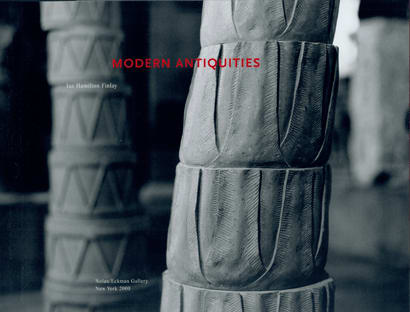
Ian Hamilton Finlay: Modern Antiquities
2000Softcover, 40 pagesRead more
Publisher: David Nolan Gallery
Dimensions: 9.75 x 8 in -

Ian Hamilton Finlay: Fleur de l'Air
Read more -
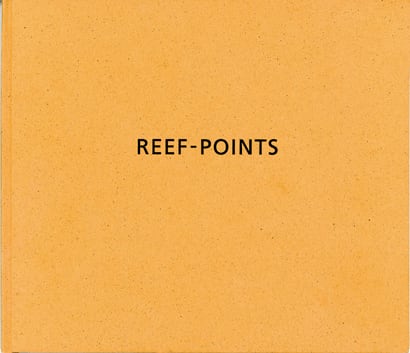
Ian Hamilton Finlay: Reef-Points
1996Hardcover, 28, 8 color ill. pagesRead more
Publisher: David Nolan Gallery
Dimensions: 7.5 x 6 in -
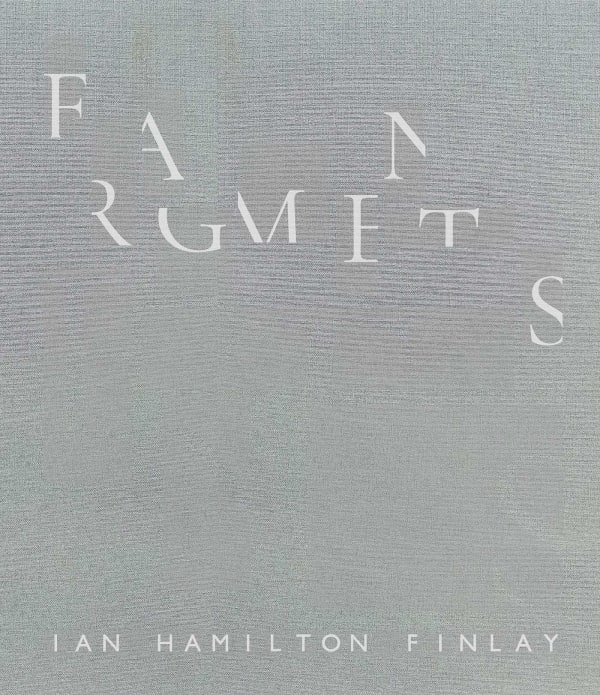
Ian Hamilton Finlay: Fragments
Stephen Bann, Tom Lubbock, 2025 Read more
-
-
Exhibitions
-

IAN HAMILTON FINLAY: Fragments
Celebrating the Artist's Centennial | Exhibition Design by David Hartt May 8 - June 7, 2025David Nolan Gallery is pleased and greatly honored to present an exhibition marking the centennial of the birth of Ian Hamilton Finlay (1925–2006). One of Scotland’s most celebrated artists, poets,...Read more -

"DIGGING"
April 1 - 27, 2023Digging: Excavation, breaking or cutting off the surface. As with the quote from Irish poet Seamus Heaney, a writer digs with their pen, and artists with their tools. David Nolan...Read more -

A HOME AT THE END OF THE WORLD
Online Exhibition | Summer Series: Part 1 of 3 September 3 - 30, 2020David Nolan Gallery is delighted to present our first online exhibition, “A Home at the End of the World,” a selection of works by gallery-and-adjacent artists that consider themes of...Read more -

THE SYSTEM OF OBJECTS
Online Exhibition | Summer Series: Part 2 of 3 September 2 - 30, 2020For our second online exhibition this summer, David Nolan Gallery is pleased to present The System of Objects , a selection of works that focuses on objects , their depiction,...Read more -

WARS
September 12 - November 2, 2019SUE COE · STEVE DIBENEDETTO · NICOLE EISENMAN · IAN HAMILTON FINLAY · GEORGE GROSZ · ANTONIUS HÖCKELMANN · SANYA KANTAROVSKY · ROBERTO MATTA · JONATHAN MEESE · LUDWIG MEIDNER...Read more -

IAN HAMILTON FINLAY
"The Garden Became My Study" September 13 - October 27, 2018David Nolan Gallery is pleased to present 'The garden became my study,' an exhibition of work by conceptual artist Ian Hamilton Finlay (1925-2006). On view from September 13 through October...Read more -

GEORGE GROSZ
Politics and his Influence September 8 - October 22, 2016MARINA ABRAMOVIĆ · WILLIAM N. COPLEY · STEVE DIBENEDETTO · ÖYVIND FAHLSTRÖM · IAN HAMILTON FINLAY · ADRIAN GHENIE · LEON GOLUB · WILLIAM GROPPER · GEORGE GROSZ · DAVID...Read more -

IAN HAMILTON FINLAY
Ring of Waves May 7 - June 28, 2013David Nolan Gallery is pleased to present its 8th exhibition of work by the celebrated Scottish artist Ian Hamilton Finlay (1925-2006). On view from May 8th until June 22nd, the...Read more -

IAN HAMILTON FINLAY
Inter Artes et Naturam November 16, 2012 - January 11, 2013Read more -

SUMMER
June 29 - August 30, 2012RICHARD ARTSCHWAGER · HANS BELLMER · WILLIAM COPLEY · STEVE DIBENEDETTO · CARROLL DUNHAM · IAN HAMILTON FINLAY · NEIL GALL · MEL KENDRICK · MARKUS LÜPERTZ · MALCOLM MORLEY...Read more -

IAN HAMILTON FINLAY
Camouflage November 4 - December 4, 2009David Nolan Gallery is pleased to announce the opening of Camouflage, an installation of sculptures and prints by the renowned Scottish artist, Ian Hamilton Finlay (b. 1925, Nassau, the Bahamas...Read more -

IAN HAMILTON FINLAY
(Neo)Classicism--A Noble Arrow September 5 - October 24, 2008To our modernist sensibility, one of the hallmarks of (Neo)Classicism is inscription, or the placing of words – usually commemorative, often epigrammatic – upon objects in a carefully chosen setting....Read more -

IAN HAMILTON FINLAY
The French Revolution September 14 - October 21, 2005'Anarchy within, invasion from without. A country cracking from outside pressure, disintegrating from internal strain. Revolution is at its height. War. Inflation. Hunger. Fear. Hate. Sabotage. Fanaticism. Hopes. Boundless idealism...Read more -

IAN HAMILTON FINLAY
Vessels September 16 - October 15, 2004Now in his 80th year, Ian Hamilton Finlay continues his garden outside Edinburgh, Little Sparta. This landscape of groves, paths, and ponds is a meditation on the sublime, where form...Read more -

IAN HAMILTON FINLAY
Maritime Works May 8 - June 26, 2003Until the advent of planes, travel by water ruled. From lowly punt to Man o' War, boats and ships were not mere conveyance: the curragh, Fifie, and Zulu were history,...Read more -

IAN HAMILTON FINLAY
Garden Works March 23 - April 28, 2000At the heart of Ian Hamilton Finlay's work is the garden outside of Edinburgh, named Little Sparta, which is one of the most beautiful gardens in the world. This magnificent...Read more -

SUMMER GROUP SHOW
Artschwager, Baselitz, Beuys, Bochner, Dunham, Le Va, Finlay, Gosewitz, Kippenberger, and Rainer June 18 - July 30, 1998Read more -

IAN HAMILTON FINLAY
Reef Points October 18 - November 26, 1996Read more -

IAN HAMILTON FINLAY
Streiflichter, Fragments from the French Revolution May 6 - June 10, 1994Read more
-
-
Art fairs
-

ART BASEL MIAMI BEACH
Online Viewing Room December 2 - 6, 2020VIP Preview: December 2-3 Public Days: December 4-6Read more -

FRIEZE LONDON
Online Viewing Room October 7 - 16, 2020VIP Preview: October 7-8 Public Days: October 9-16Read more -

ART BASEL
Online Viewing Room June 17 - 26, 2020David Nolan Gallery presents a dynamic group presentation highlighting selected gallery artists engaging across various media, with a particular focus on abstraction and figuration. The...Read more -
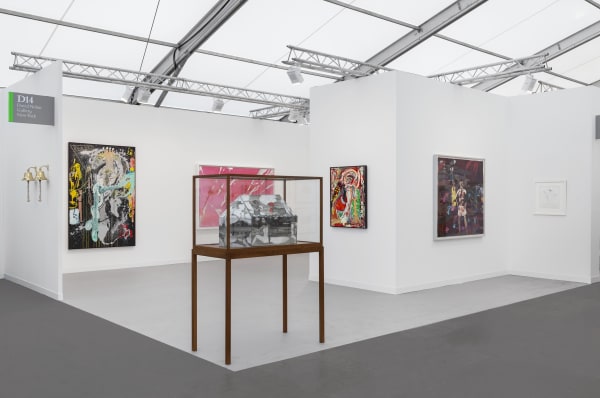
FRIEZE LONDON
October 4 - 7, 2018Read more -

ART BASEL MIAMI BEACH
December 3 - 6, 2015Read more
-
MAILING LIST SIGN-UP
By completing this form, you confirm that you would like to subscribe to DAVID NOLAN’s mailing list and receive information about exhibitions and upcoming events. Your email address will be used exclusively for the mailing list service.
* denotes required fields
We will process the personal data you have supplied to communicate with you in accordance with our Privacy Policy. You can unsubscribe or change your preferences at any time by clicking the link in our emails.
